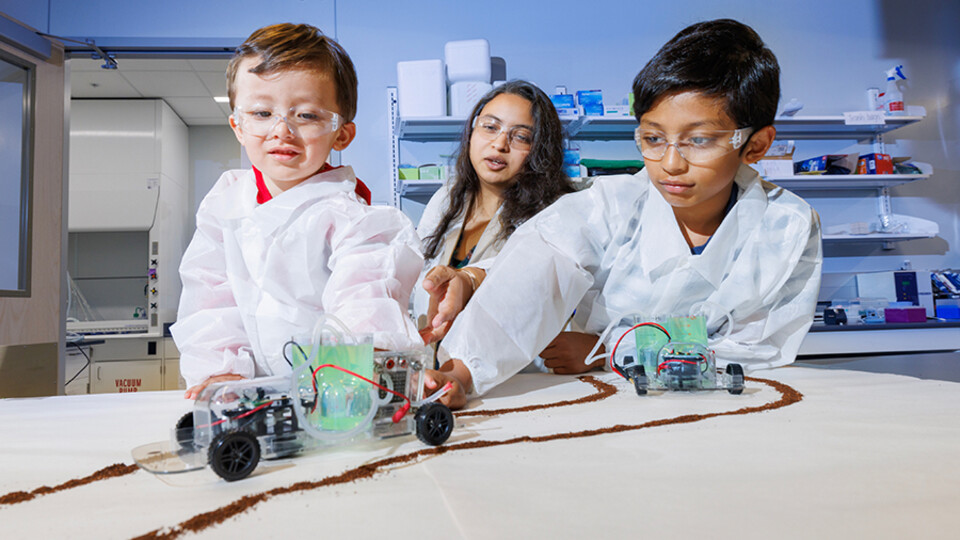· 4 min read
Dishari seeking greener energy by researching plant polymers

Energy conversion and storage devices may produce electricity without emitting greenhouse gases, but the materials currently used to build these devices are not necessarily green.
Shudipto Dishari, the Ross McCollum associate professor of chemical and biomolecular engineering, has recently begun work on research utilizing plant-based materials that could revolutionize the way electrochemical devices transport charge-bearing ions and produce electricity. The work is supported by a three-year, $489,134 grant from the National Science Foundation.
“This project will uniquely valorize the remnants of corn harvest and Christmas trees and provide source material for a new polymer, which will be eco-friendly, cheap and efficient,” Dishari said, “Through this work, we are also bringing a new concept in energy research — green energy by using green materials.”
For the past half-century, fluorocarbon-based polymers, such as Nafion, have been used to make electrodes for hydrogen fuel cells, electrolyzers, flow batteries and other electrochemical devices. These polymers, Dishari said, are not only expensive but also have been linked to human health and environmental concerns.
The thin layers of these polymers also slow the flow of protons to the electrode and delay the electrochemical reaction, impacting the fuel cell efficiency.
Dishari’s team is embracing these cost-performance challenges and bringing a promising low-cost, perfluoroalkyl substances-free, and efficient solution by using lignin, an organic polymer that is abundant in the walls of plant cells.
Lignin is a “branched polymer” with a three-dimensional structure that is more porous than currently used polymers. Openings within the lignin would, Dishari said, allow for a freer flow of protons, making many devices more efficient.
“This NSF grant will help us engineer electrodes using lignin-derived polymers to speed up the proton transport,” Dishari said. “That means all the clean electrochemical systems — which produce electricity but not greenhouse gases — can also be renewable and sustainable. It’s a big challenge and a very new way to design energy materials.”
Every year, a huge amount of lignocellulosic biomass is generated by agricultural farms, pulp and paper industries, and cellulosic biorefineries, but only one or two percent is utilized or valorized. It’s often burned as a secondary heat source or just discarded.
“Lignin can be converted from waste to wealth,” Dishari said. “By using these biomaterials, we can ultimately make electrochemical devices like hydrogen fuel cells efficient and cheaper.
“There is a large price difference between fuel cell-powered vehicles and battery-powered vehicles, and this could help get us to a point where they’re a lot closer in terms of cost and performance.”
It also could benefit the environment by keeping more potentially dangerous materials, like PFAS, out of landfills by making products such as fuel cells more eco-friendly.
“Lignin could revolutionize the electronic waste recycling concept,” Dishari said. “Right now, you cannot dispose of a fuel cell or battery directly because they are not biodegradable. If we can find a way to create these devices out of materials that are plant-based, it could have a profound, positive effect on our world for a long time.”
Potentially, that would include changing the way we use, manufacture and dispose of e-wastes, and producing new avenues of income for farmers and agriculture-based businesses.
“The reason I was motivated to this specific area of research and this project is that we are in an agriculture-focused zone of the country,” Dishari said, noting that Nebraska ranks third in the U.S. in corn production and is a leader in ethanol production. However, she said, cellulosic ethanol production may not be economically viable without monetizing more of the source materials.
“If we can take something that is typically thrown away and create a valuable product that can be used for clean, green energy, then we will also be supporting the bioeconomy, the energy economy, and the circular economy of Nebraska and the world,” Dishari said.
With this NSF grant, Dishari and the researchers in her lab will also work closely with Nebraska STEM teachers on an innovative curriculum that could “gamify” a course on polymers.
“This course curriculum is inspired by Pokémon (the card game), one of the perks of having a 7-year-old at home,” Dishari said. “(The game) is a fight between two different characters. When we are choosing materials, we are assessing the strengths and weaknesses of them and it’s a competition. If we can gamify that process, maybe we can make learning more interesting and get more students excited.”







